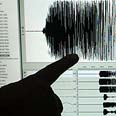
Second time on Sunday: Quake registered in Kinneret
Only hours after mild quake originating in northern Lake Kinneret is registered, additional 3.6 magnitude quake shakes north. 'It was mild, but still noticeable. After four times, you begin to think about what you're going to do,' resident says
The Israeli Geophysical Institute confirmed the quake's 3.6 magnitude and pinpointed the northern part of Lake Kinneret as its epicenter. Early Sunday, at roughly 11:50 pm, an additional earthquake of the same magnitude and epicenter (5 km northeast of Kibbutz Ginosar) was registered.
Related stories:
- 3rd earthquake in 4 days hits north
- Mild earthquake hits north Israel
- Greece quake of 6.4 magnitude felt in Israel
Mirriam Salah, who works at the Golan Tiberias Hotel, said that seven minutes before 4 pm she felts the ground shaking for a second time since noon.
"When the quake hit, most of the hotel's guests – most of whom are from abroad – were out traveling," Salah said. "Anyway, we have a well prepared shelter in the hotel; we received directions from the army some six months ago about what to do in case of an earthquake.
"In the meantime, there have been no cancelations because of the recent quakes. If God forbid something was to happen, we would know what to do – but let's hope that doesn’t happen," Salah said.
This is Salah's fourth earthquake: "My computer was shaking and three other workers who were with me felt it as well. I wasn't frightened because it was mild, but when it happens four times (in a week) it makes you think about what you're going to do."
Michael from Tiberias echoed her words, saying "the first time it happened at around noon my computer screen shook, this time it was milder, but I was still noticeable."
The tremor caught some unprepared. Yaakov Amsalem, found himself on the fifth floor offices of his travel agency. "We have 200 workers and we felt the discomfort of the last earthquake as well as that from noon, but we weren’t frightened," Amsalem recalled.
"As a travel agency, we are well acquainted with earthquakes, for example in Japan or California, so we kept our cool. Our crews are prepared to carry out directives in the case of a stronger quake, God forbid, but in the meantime everything is still calm, and the region is still pastoral and people are still reserving rooms in hotels."
A 3.6 magnitude earthquake was felt in Lake Kinneret and Hula Valley region at around 2:30 am Friday night. An additional quake measuring 3.5 on the Richter scale also hit the region at 9:20 pm Thursday night. In both cases no reports of injury or damages emerged and the Geophysical Institute of Israel located both their epicenters in Lake Kinneret.
A week ago a 6.4-magnitude earthquake which originated west of the island of Crete was felt in Israel. The center of the quake was 22.5 miles below the seabed, some 43 miles west of Chania on Crete, the US Geological Survey said. Israelis reported to experiencing the quake, mainly in locations in the center and south of Israel.
What's expected next?
"Either nothing will happen or there will an earthquake of much larger magnitude," said Dr. Avi Shapira, chairman of the inter-ministerial steering committee for earthquake preparation.
"A very frequent occurrence of earthquakes is rare but it's not impossible. It means that the region is unstable and in the process of rifting."
The director of the Geophysical Institute, Dr. Uri Frieslander, said that "it's impossible to completely rule out the possibility of a stronger quake, but it is possible that these smaller tremors will not precipitate anything. There have been just as many cases of small tremors preceding larger earthquakes as not."
On the other hand, Professor Amotz Agnon, a geologist and geophysicist, expressed concern that the recent earthquakes in northern Israel may indicate that a large event is ahead.
"Meanwhile, four earthquakes were felt, and four more were not, all in the area of the Kinneret. If the phenomenon keeps occurring we can definitely see it as a precedent for a big event," said Agnon.
"In the '90s there were three earthquakes felt in Israel: One in 1993 in the Eilat Bay measuring at 6 on the Richter scale, the second took place in Nairobi in 1995 and was a 7 – it resulted in deaths and destruction of buildings – and the third was in Cyprus in 1996, also registering a 7 plus. All three were preceded by the type of tremors we are currently experiencing."
A report complied by the geological institute nine years ago determined that in case a big earthquake hits Tiberias, avalanches and landslides may occur. Experts noted that the findings were still relevant and that buildings in the area were not fortified to endure earthquakes.
In 1759, an earthquake brought down Tiberias' walls and another in 1837 wreaked additional havoc.
"We've been preparing for the past few years – not just now," Tiberias Mayor Zohar Oved told Ynet Sunday. "We've undergone emergency and earthquake drills."
Michal Margalit contributed to this report
- Receive Ynetnews updates directly to your desktop










